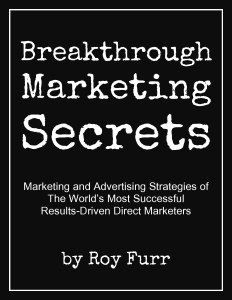
My upcoming book, Breakthrough Marketing Secrets, which I’m writing while you watch on this site and in my daily emails!
Hey there Rainmaker, today you get part two of my chapter on the “My Business Is Different” virus…
Again, we’re continuing on with the Mental Game section of my upcoming book Breakthrough Marketing Secrets, which I’m writing while you watch…
Yesterday, I addressed the “My Business Is Different” virus, and gave you an illustration to help you see the universal principles of building a business from an entirely different perspective.
That was, I suppose, the “light side” of this lesson. Today, we look at the “dark side” of the lesson. Which is the long-term of outcome of allowing yourself to be caught up in the isolationism that thought virus causes.
This was written as a sidebar or sub-chapter of the “My Business Is Different” chapter, and that’s how it will appear in the final book.
The language is a bit strong, and I use it with some reservation. However I also believe it’s accurate — in just about every aspect. And so I still use it.
Here goes!
—
A gross term for a very real problem in nearly every industry…
Throughout most of modern human history, when kings and queens have ruled, the royalty believed blood established superiority. Ancient Egypt, Inca Peru, Central Africa, Mexico, and Thailand all allowed royal siblings to intermarry. In Europe, siblings seldom married, but “kissing cousins” were common among royalty in Prussia, France, England, and Spain.
In Spain, the Habsburg dynasty’s inbreeding over 200 years led finally to Charles II, a king riddled with health and developmental problems. He didn’t speak until he was four, didn’t walk until he was eight. He had trouble chewing food, and was impotent. And he was the last Spanish Habsburg to hold the crown.
The end result of the royals’ inbreeding — incest — was their downfall.
A more successful way of breeding — geneticists will now tell you — is to marry and breed diversely. This creates healthier, hardier, more robust offspring.
The same thing applies to ideas — particularly in the area of marketing.
It’s very common — if you follow the belief of “my business is different” — to want to look to those within your industry as your sole source of inspiration and best practices for building your business.
And in the short term, particularly with a new business, this can be seen as beneficial. After all, if you sum up all that the other businesses are doing in terms of selling and marketing, find the average, and copy that, you’ll probably come out as an average business in your industry. Just like over the first few generations of inbreeding, the royals appeared to do okay, and maintained a tight rule.
Through time though, isolating the marketing, innovation, and business growth processes to what’s been proven in your industry leads to massive under-performance of potential.
And what’s worse, you’re unlikely to really feel the defects until they’re so deeply entrenched in your business’s genetics that it’s hard to turn back. Your downfall will be built in by the point you recognize the problem.
Because of the parallels of these inbred ideas and inbreeding of royals (or others), some of my colleagues have used the term “marketing incest” to describe this insistence on turning only to those in one’s own industry for marketing fodder.
I have always instinctually gone the opposite direction. In favor of what’s universal — ideas that can interbreed across businesses and industries — over confining myself to an industry- or market-specific silo. And I’ve seen, time and time again, that a business-doubling (or better!) breakthrough can come simply by recognizing an idea that’s worked in one area, and taking it to another.
I’ll talk in more detail about pricing later, but this is an apt example. I’ve seen in the information product space (published goods, training, seminars, and similar) that often times a product can be radically mis-priced, and a significant increase in price can yield just as many sales, at higher revenues and higher profits. It’s rare that this same thinking is applied in physical products, where the product price is often some multiple of cost of goods sold.
I was speaking with a client who sells a proprietary backup solar generator, and encouraged him to apply this thinking. We boosted the price by 29%, increasing the margin by 60% at the same time. He tested this new higher price, and the results were consistent with what I’d seen in the information product and publishing industry. No fewer sales, but 29% higher revenues and 60% higher profits. Customers just as satisfied. But my client will make an extra $500,000 or more in profits this year, on this one decision.
Every concept in this book has the potential to have similarly transformative impact. If you see something that nobody in your business or industry is using, don’t think “but my business is different.” Because now you know that assumption only leads to the negative effects of marketing incest. Instead consider that there may be a way to apply — or at the very least, test — the concept in your business. And perhaps it will be the breakthrough you’ve been looking for.
—
Yours for bigger breakthroughs,
Roy Furr
Editor, Breakthrough Marketing Secrets



